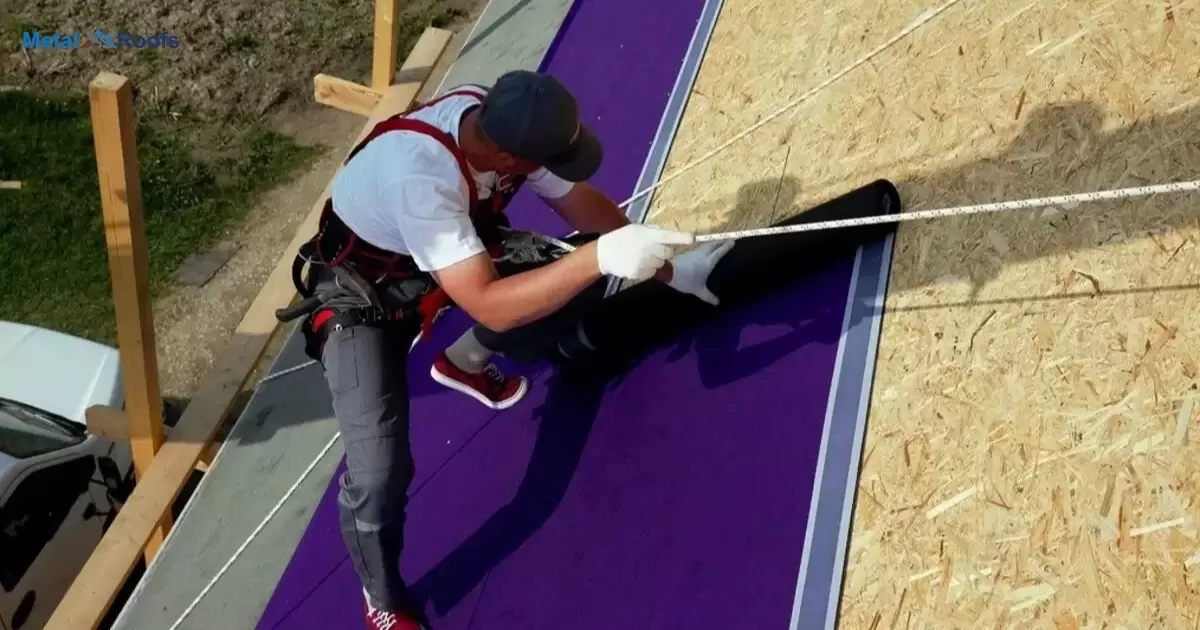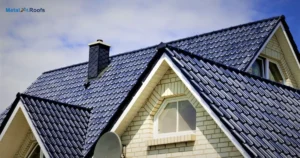Ice and water shield is crucial under metal roofing. It prevents leaks and ice dams, enhancing roof durability. This underlayment ensures your roof stays watertight and protects against weather damage. Experts recommend its use to maintain a secure and long-lasting roofing system.
Do you need ice and water shield under metal roofing? Many homeowners wonder if this extra layer is worth it. The answer is yes. It protects your roof from leaks and ice damage. Learn why this underlayment is a smart choice for your home.
Adding ice and water shield under metal roofing is a wise investment. It strengthens your roof against leaks and ice dams, ensuring long-term durability. To tie into an existing metal roof, this underlayment provides peace of mind during harsh weather conditions, making it a recommended choice by roofing experts.
Key Takeaways
- Prevents water leaks.
- Stops ice dam damage.
- Increases roof longevity.
- Keeps roof watertight.
- Commonly advised for metal roofs.
Roofing Ice And Water Shield
Ice and water shield gives extra protection for roofs. It prevents water from leaking through the roof. This is especially important under metal roofing. The shield keeps the roof strong and lasts longer. It makes sure your roof stays dry.
Ice and water shield also stops ice dams. Ice dams form in cold weather and can cause big damage. The shield helps protect against this. Roofing experts recommend using it. This added layer gives peace of mind. Your roof will stay secure and watertight.
Roof Underlayment For Metal Roof
Roof underlayment is important for metal roofs. It gives extra protection against water leaks. It also helps stop ice dams from forming in cold weather. This keeps your roof safe and dry. Underlayment adds to the life of the roof. It is a smart choice for any metal roof.
Many roofing experts suggest using underlayment. It gives peace of mind by keeping your roof watertight. This layer is a strong defense against weather damage. It is especially useful in areas with heavy snow or rain. Underlayment helps your roof last longer and stay in good shape.
What Goes Under Metal Roof?
Under a metal roof, you need a good underlayment. It acts as a barrier against water. Ice and water shield is a top choice. It stops leaks and prevents ice dams. This underlayment adds extra protection. It helps keep your roof strong and durable.
Some people also use felt or synthetic underlayment. These materials provide good protection too. They go under the metal roofing panels. They help with insulation and noise reduction. The right underlayment makes your metal roof last longer. It keeps your home safe and dry.
Ice Water Shield Under Metal Roofing

Ice and water shield gives extra protection under metal roofing. It prevents water leaks by sealing around nails and screws. This layer stops water from getting into your home. In cold weather, it helps prevent ice dams. Ice dams can damage roofs if left unchecked.
Using ice and water shield makes your roof last longer. It adds durability to your roofing system. Many experts recommend this underlayment. It keeps your roof watertight, giving you peace of mind. It is a smart choice for anyone with a metal roof.
Underlayment For Low Slope Metal Roof
Underlayment is crucial for low slope metal roofs. It adds an extra layer of protection. This helps prevent water leaks. The underlayment also stops ice dams from forming. This is important in cold climates. It keeps the roof durable and strong.
Experts recommend using ice and water shield. It enhances the roof’s lifespan. This underlayment gives peace of mind. It ensures the roof stays watertight. Low slope metal roofs need this added security. It’s a smart choice for long-term protection.
Gaf High Temp Ice And Water Shield
GAF High Temp Ice and Water Shield offers strong protection. It stops water leaks and protects against ice dams. This underlayment works well in hot climates. It can handle high temperatures without breaking down. This makes it a great choice for metal roofs.
The shield increases roof durability. It adds an extra layer of security. Many experts recommend it for peace of mind. Installing this shield helps keep your roof watertight. You can trust it to protect your home from the elements.
Where Does Ice And Water Shield Go On A Roof?
Ice and water shield goes in key areas on a roof. First, place it along the eaves where the roof meets the gutters. This prevents damage from ice dams. Next, put it in valleys where two roof sections meet. Water can pool here, so extra protection is needed.
You should also apply it around roof penetrations. These include chimneys, vents, and skylights. Finally, use it along the roof’s edges and low-slope areas. These spots are prone to water damage. Using ice and water shield in these areas ensures a more secure roof.
High Temp Ice And Water Shield

High Temp Ice and Water Shield works well under metal roofing. It can handle high temperatures and harsh conditions. This shield protects your roof from leaks and water damage. It is made for tough weather and long-term use.
Using High Temp Ice and Water Shield can extend your roof’s life. It adds extra protection against ice and water issues. It is a reliable choice for metal roofs in extreme conditions. This shield keeps your home safe and dry.
Types Of Ice And Water Shield
Ice and water shield is a roofing material designed to protect against ice dams and leaks. Here are some common types:
Self-Adhering Membranes
These are the most common type. They have an adhesive backing that sticks directly to the roof deck. They’re easy to install and provide a strong seal.
Modified Bitumen Membranes
These are made with a polymer-modified bitumen layer. They offer flexibility and durability. They can be installed using heat, cold adhesive, or self-adhesive methods.
Rubberized Asphalt Membranes
These are made from asphalt mixed with rubber or plastic. They provide excellent waterproofing and flexibility, and are also self-adhesive.
Polymer-Modified Bitumen Membranes
These have a bitumen base modified with polymers for added strength and flexibility. They often come with a protective granule surface.
Peel-and-Stick Membranes
These are similar to self-adhering membranes but may require a release film to be peeled off during installation. They are easy to apply and effective against water intrusion.
Granular Surface Membranes
These have a layer of granules on the surface, which helps protect against UV rays and physical damage. They are often used in exposed applications.
High-Temperature Membranes
These are designed to withstand high temperatures, making them suitable for areas with extreme heat or for use under metal roofs.
Each type has its own set of features and benefits, so the best choice depends on your specific roofing needs.
Benefits Of Using Ice And Water Shield
Prevents Ice Dams: Ice and water shield protects against ice dams, which can cause leaks and damage to your roof.
Waterproof Barrier: It creates a waterproof barrier that keeps water from seeping under shingles, especially in areas prone to leaks.
Durable Protection: It offers long-lasting protection against harsh weather conditions like rain, snow, and wind.
Improves Roof Longevity: By preventing water damage, it helps extend the life of your roof.
Easy to Install: It’s relatively easy to apply during roof installation or repair projects.
Cost-Effective: While it might seem expensive, it saves money in the long run by preventing costly repairs.
Protects Vulnerable Areas: It’s especially effective in protecting areas like valleys, eaves, and around chimneys where leaks are most likely to occur.
Reduces Maintenance: It lowers the need for frequent roof inspections and maintenance.
Is There A Right Way To Install Metal Roofing Underlayment?
Installing metal roofing underlayment requires careful attention to ensure effectiveness. Start by cleaning the roof thoroughly. Next, roll out the underlayment in overlapping rows. Secure it with nails along the edges and seams. Trim excess material carefully. Finally, check for any gaps or wrinkles.
This method ensures a secure and watertight installation, essential for protecting your home from leaks and weather damage. Many experts recommend following these steps to achieve the best results with your metal roofing underlayment installation.
Proper Installation Of Ice And Water Shield

Proper installation of ice and water shield is crucial for a good roof. Start by cleaning the roof surface and making sure it is dry. Roll out the ice and water shield along the eaves and valleys. Press it down to remove air bubbles and ensure a tight seal. Make sure the edges overlap to prevent leaks.
Next, trim any excess material from the edges. Install the metal roofing over the shield according to the manufacturer’s instructions. Check for proper alignment and secure the roofing panels. A well-installed ice and water shield adds protection and helps the roof last longer.
Frequently Asked Questions
Should You Put A Moisture Barrier Under A Metal Roof?
Yes, you should put a moisture barrier under a metal roof to prevent moisture issues.
What Kind Of Barrier Do You Put Under A Metal Roof?
For a metal roof, use synthetic underlayment, felt paper, or ice and water shield for protection.
Should I Put Ice And Water Shield On My Roof?
Yes, you should use ice and water shield for extra roof protection and durability.
Conclusion
Using ice and water shield under your metal roofing is highly recommended. It adds an extra layer of protection against leaks and ice dams. This helps extend the lifespan of your roof by ensuring it stays watertight and resilient in all weather conditions.
Experts emphasize its effectiveness in preventing costly damage and providing peace of mind to homeowners. Investing in ice and water shield can significantly enhance the durability and reliability of your roof.











